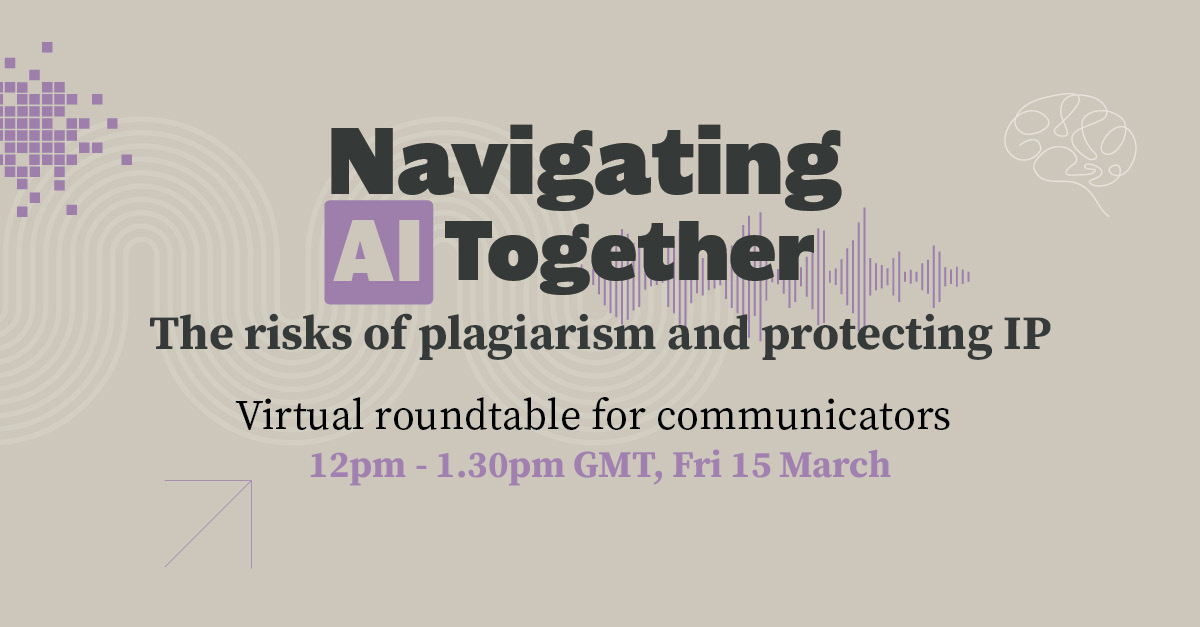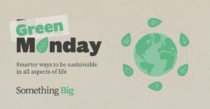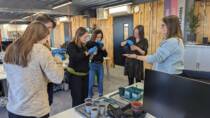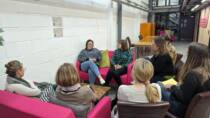Navigating AI together: the risks of plagiarism and protecting IP
By Sally Pritchett
CEO
In a thought-provoking session on AI, plagiarism and IP, we unravelled the challenges facing communicators using generative AI.
In our most recent ‘Navigating AI together’ session, we went on a journey to explore the legal challenges around the use of generative AI tools. We were delighted to be joined by Alex Collinson from Herrington Carmichael, a seasoned expert in commercial and intellectual property law.
The purpose of the ‘Navigating AI together’ series is to foster a community dedicated to responsible AI usage and to work through these challenges with clarity and integrity, together. In this recap of our discussion, we’re shining a light on the issues around AI and charting a path towards ethical and informed AI usage.
What do we mean by intellectual property, copyright and trademarks?
Many of us are likely guilty of using language like intellectual property, copyright and trademarks almost interchangeably. But to understand the legal landscape around AI, we need to get these terms nailed down.
- Intellectual property (IP): refers to creations of the mind, such as inventions, literary and artistic works, designs, symbols, names, and images used in commerce. IP is protected by laws which give the creators or owners exclusive rights to use their creations or discoveries for a certain period of time.
- Copyright: Copyright grants exclusive rights to creators of original works, such as books, music, and software, allowing them to control reproduction, distribution, and other uses for a limited time. Copyright acts as a deterrent to those who may wish to profit from reproduction, and can be licensed which can create a revenue stream for your business.
- Trademark: Trademarks protect words, symbols, or designs that distinguish goods or services, providing exclusive rights to their owners to prevent confusion among consumers and maintain brand identity.
Common copyright misconceptions
Even before we get into the new, complex and unclear realm of generative AI, Alex shared with us that there are a lot of common misconceptions:
- “Everything on the Internet is free to use”: Contrary to popular belief, just because something is freely available online doesn’t mean it’s in the public domain. Users must be cautious about where they obtain information and how they use it.
- “My name is protected by copyright”: Names and symbols can’t be protected by copyright; instead, they fall under trademark law. Trademarks prevent others from using similar names or symbols that could cause confusion in the marketplace.
- “You have to register your copyright to protect it”: Under English law, there’s no requirement to register copyright. Copyright protection automatically applies to works once they’re created, including artistic and literary works.
What the law says about generative AI
While the law is not quite up to speed with generative AI, Alex shared some interesting case examples to help us better understand the legal landscape.
Copyright
Alex shared with us a high-profile case, Getty Images (US) Inc v Stability AI Ltd [2023] EWHC 3090 (Ch), that highlights the difficulty generative AI is causing within copyright law. Getty Images alleged that Stability AI unlawfully scraped images from other websites to train its AI model, resulting in infringement of copyright and trademarks.
Despite Stability AI seeking summary judgment (without a full trial), the court refused, recognising the novel issues surrounding AI and copyright law. These legal nuances reveal the need for the law to adapt to the evolving landscape of AI technology, with more cases expected to emerge.
It is possible that copyright could be infringed when AI systems are trained, if this process involves copying a substantial part of copyright works that are still within the terms of protection. However, the issue regarding whether copying will be deemed to have occurred where a generative AI system has been trained on copyright works is not straightforward.
Potential issues include:
- Proving the use of copyrighted works in training AI: proving that copyrighted works were used to train and develop a generative AI system poses challenges due to the lack of transparency in data usage.
- Jurisdictional issues: determining the location of training and development activities, especially in cases involving online communication, can be complex. Although even if the activities occurred outside the UK but targeted the UK public, copyright law may still apply.
- Permitted acts under copyright law: Assessing whether any infringement occurred involves considering permitted acts outlined in the Copyrights Act. These acts include fair dealing defences, such as criticism, review, quotation, parody, caricature, and pastiche, which provide exceptions to copyright restrictions.
Trademarks
Given how new generative AI is and the evolving legal landscape, there are very limited case studies available. However, Alex explained how longer existing AI applications may help us to understand potential future legal implications.
AI-driven recommendation systems, commonly used in e-commerce, analyse user data to suggest products based on preferences and behaviour. Amazon, for instance, employs such AI technology.
In the case of Cosmetic Warriors and Lush v Amazon ([2014]EWHC 181 (Ch)), Amazon was found to have used Lush products and branding on its website to attract customers and recommend other products without Lush’s consent. Lush claimed trademark infringement, asserting that its intellectual property rights were violated, with the court ruling in its favour. This case highlights the importance of protecting trademarks within the digital marketplace.
The ethical dilemma
While the law hasn’t yet adapted to the emergence of generative AI, as communicators, we can’t afford to sit back and wait while these tools that can enhance creativity and productivity are available to us. With the ongoing legal uncertainties, it’s up to us to evaluate the ethical implications of our communications practices.
Consider a scenario shared during our session, involving Keith Haring’s artwork and an AI-generated copy produced on Midjourney, a licensed platform. Keith Haring is perhaps most famous for his art used in the iconic Change4Life public health campaign.
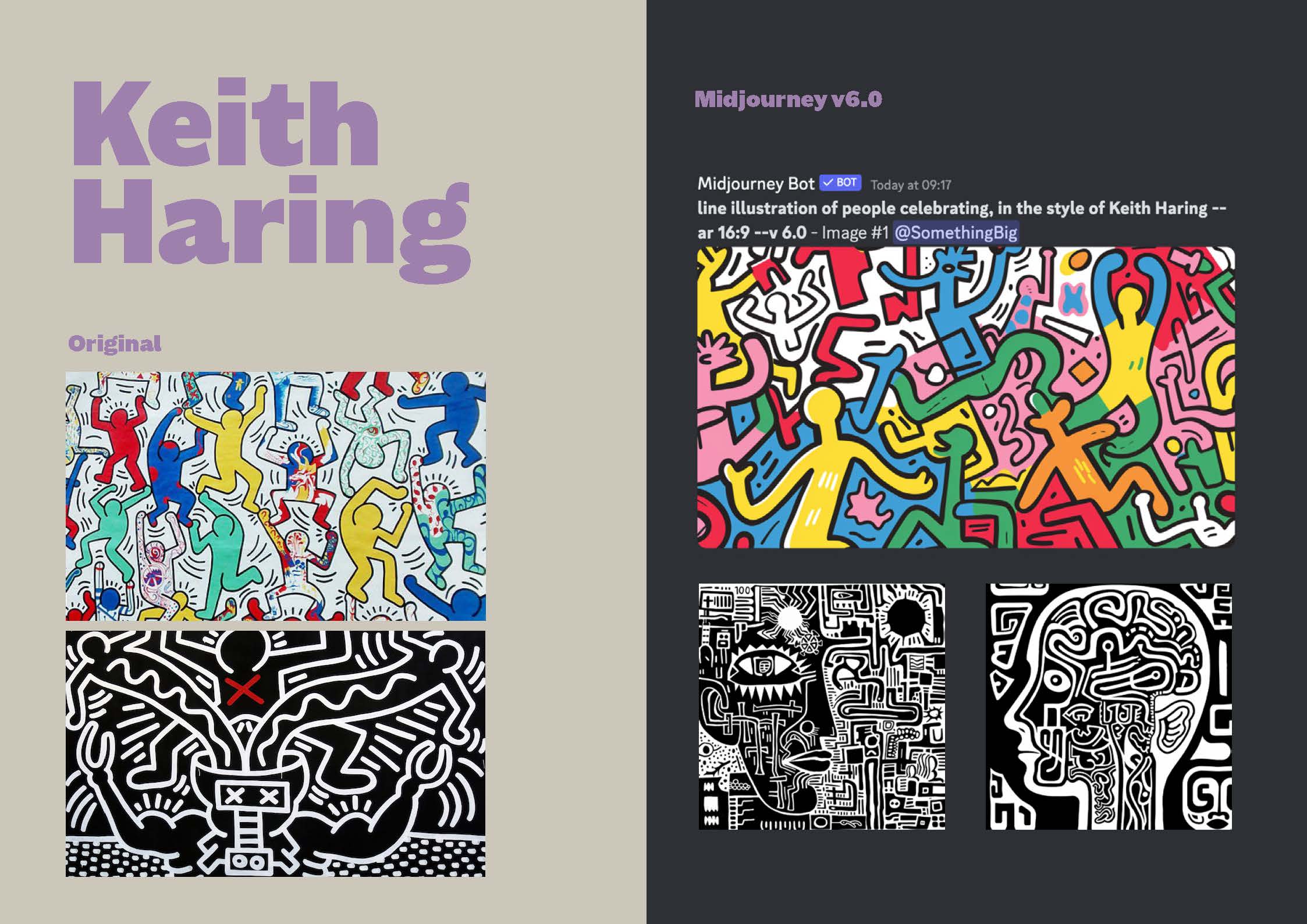
The Keith Haring Foundation, a charitable organisation dedicated to children in need and those affected by HIV/AIDS, holds the rights to Haring’s iconic artwork.
However, we posed a hypothetical situation where the government wants to commission a new public health campaign, once again using Haring’s renowned illustrative style. As our Midjourney example shows, instead of licensing art from the Keith Haring Foundation, they could potentially use AI-generated images.
This capability raises ethical and legal concerns regarding intellectual property rights. Despite the AI’s capability to mimic Haring’s style, using these images without consent from the Keith Haring Foundation could potentially infringe upon their IP rights. Not to mention the ethical impact of not licencing the images from a charitable foundation.
This example reflects the importance of ethics when incorporating AI-generated content into communication strategies, while we wait for the law to catch up.
We’d like to thank Alex for guiding us through this complex topic. If you’d like to explore the legal implications of generative AI further, we encourage you to connect with Alex on LinkedIn to stay updated on future discussions and insights.
Navigating AI together
Our upcoming session will delve into the role AI should play in marketing efforts and consider how marketers can best leverage AI to streamline tasks and free up valuable time.
If you’d like to be kept in the loop for details on this insightful discussion, get in touch.
Q3 2024 Awareness Days Calendar
By Sally Pritchett
CEO
Download your free Awareness Days Calendar for Q3 2024.
Don’t miss an important date in the third quarter of the year – July, August and September – with our downloadable calendar that includes key employee wellbeing, sustainability and environmental, and diversity and inclusion awareness days.
These are all important topics that should be high on the agenda for every business. Our Q3 2024 Awareness Days Calendar can help you:
- Make plans for employee wellness programs
- Highlight your sustainability efforts
- Stay focused on diversity and inclusion initiatives
- Engage employees in meaningful discussions
- Acknowledge important events for both colleagues and customers.
If you’re looking for support to make the most of these opportunities, get in touch to see how we can help.
Download our Key Awareness Days Calendar for Q3 2024
4 steps to making generative AI an ally to inclusion
By Sally Pritchett
CEO
Discover four practical steps to mitigate bias in generative AI and ensure inclusive, authentic representation in your AI-powered communications.
AI offers amazing opportunities for communicators, from writing creative content to bringing to life a visual idea in a matter of seconds. But its power comes with a challenge: inherent biases.
Generative AI has been trained on human-created content, and so has inherited deep-seated bias built in. This bias can, and often does, unintentionally permeate AI-generated content, reinforcing stereotypes and misconceptions.
So as the human hands guiding AI, what can we do to help overcome these biases and use AI as a tool to foster inclusion and authentic representation?
1. Nurturing AI as responsible guides
It’s important that we hold the hand of AI and safely guide it as generative AI learns from the language we use. We need to ensure we understand the EDI landscape ourselves thoroughly first before we can expect AI to generate outputs that are genuinely inclusive and authentically representative.
2. Navigating our human bias
The second step to making AI an ally to inclusive communications is self-reflection. We’re human, and we’re fallible, and it is important to remember that in the context of EDI. As humans, we do form stereotypes – it’s a coping mechanism and our brain’s attempt to simplify the barrage of information we encounter daily.
We must remain vigilant – consciously slowing down and actively recognising these stereotypes within ourselves so we do not bring them into our communications with AI.
3. Increasing awareness of our unconscious biases
Unconscious bias refers to the automatic attitudes and stereotypes that influence our judgments and actions without our conscious awareness. Shaped by our experiences and societal influences, these biases impact how we view others.
If you’re considering using AI within your communications, then you must understand what your own unconscious biases are. The Harvard IATs – Implicit Association Tests – are a useful tool to help you begin to do this. Set up by a collaboration of US researchers in 1998, Project Implicit aims to collect data on our biases as we learn about ourselves. We’d recommended picking a test identity characteristic you think you don’t carry bias on and one you think you do – and see how it plays out. These tests can help you identify where your unconscious biases could influence AI.
4. Learning from our mistakes
AI is still a relatively new tool for many of us – we are still learning how to get the best out of ChatGPT or how to write an effective prompt on Midjourney. We are naturally going to make mistakes as we learn how to use different AI platforms. But we must learn from these and identify where we perhaps need to reword a prompt or change the language, we are using to generate more inclusive results. By taking our time to craft prompts carefully to guide unbiased outcomes we can minimise our mistakes and foster greater inclusion.
But what about if AI makes a mistake and leans on bias or stereotypes? We can help it learn from its mistakes too! By offering corrective feedback, we can help steer AI responses towards being more inclusive.
Navigating AI together
Our ‘Navigating AI together’ workshop series has been providing a safe and open space for communicators to discuss various aspects of AI.
This time, recognising the pressing need, we’re focusing on intellectual property and copyright issues. It’s an area that many communicators have been struggling to grapple with, so in our next session, on Friday 15th March, we’re going to delve into it together.
We are delighted to be welcoming Alex Collinson, from Herrington Carmichael, who specialises in commercial and intellectual property law matters. Alex will lead an insightful discussion covering copyright, brand protection, confidentiality concerns, and real-world cases of AI IP infringement.
Should your business start a podcast?
By Sally Pritchett
CEO
Discover how podcasts can help you engage your customers and employees.
In recent years, podcasts have continued to grow in popularity. In 2021, over 19.1 million people in the UK listened to podcasts, and this is predicted to grow to 28 million listeners by 2026. We’re also seeing people listening to podcasts on a regular basis – 25.5% of people say they listen to podcasts weekly.
Podcasts are becoming an effective communication channel for a whole host of businesses across different industries. Just like how we now consider social media a fundamental way to engage with our customers, marketers and comms professionals are starting to view podcasts in the same way. But podcasts aren’t just relevant for your customers or external audiences, they are a great way to increase engagement with the workforce too.
So how can you effectively leverage podcasts as a communications channel for your business?
Positioning your experts as thought leaders
One of this year’s trends in podcasting is the growing demand for educative content delivered in an entertaining and interesting way, as listeners want to stay informed and be inspired. Podcasts provide an opportunity for experts in your business to reach new audiences and share their knowledge, experience, and insights in an engaging way.
Connecting through real-time interaction
Another podcasting trend growing in popularity this year is live podcasting. Providing real-time engagement and a stronger connection with listeners, live podcasting provides an opportunity to deliver truly authentic content. Listeners have the opportunity to ask questions or guide the conversation in the way they want it to go and engage with speakers on a more personal level.
Exploring your brand personality
With podcasts typically having a more friendly and informal tone, they provide an opportunity for you to bring a more conversational element to your brand personality. Whilst listeners are looking to be entertained by podcasts, many are also keen to learn something new. This presents a real opportunity for businesses to provide informative and interesting content in a relatable and enjoyable way.
Communicating with employees
When communicating with employees, it can sometimes be difficult to break through the noise of day-to-day communications. Office-based employees constantly receive emails or instant messages, whilst frontline staff may be on the road or working in the warehouse where checking these channels might be more difficult. A podcast gives you the opportunity to engage employees through a different channel, perhaps whilst they are driving or commuting.
Giving employees a voice
Podcasts don’t just have to be a way to communicate with employees – they are a great opportunity to give employees a chance to talk about the things that matter to them. Whether you invite employees to be guest speakers or start an employee-led podcast series, this can be a great way to start conversations about important topics within your workforce.
Our top podcasting tips
- Release episodes regularly. People look forward to the next episode of their favourite podcasts being released – just like they would with the next episode of a TV series.
- Make sure your podcast is available on all the most popular platforms, such as Apple Podcasts and Spotify.
- Promote your podcast via your other channels. 32% of people hear about new podcasts through social media.
- Keep the tone conversational and friendly. Listeners typically find these types of podcasts relatable and enjoyable as they can feel like a conversation they would have themselves.
- Consider bringing in guest speakers who are relevant to the target audience.
If you’re looking for support in starting your podcasting journey, we’re here to help. From communications plans to recording podcast episodes, we can provide the support you need.
Creating a culture of sustainability
By Sally Pritchett
CEO
How can businesses promote environmental action and cultivate a culture of sustainability among employees?
Businesses that embrace sustainability can build trust with customers and stakeholders, improve their reputation, and foster a positive work environment. However, despite the growing importance of sustainability, many businesses are struggling to meet their goals. One key reason for this is that they often fail to properly engage their employees and take them on the sustainability journey.
As organizations adapt to combat climate change, the focus must shift inward – towards internal culture and how employees embrace the necessary changes to minimize their impact on the planet. Fostering a sustainability culture isn’t just advantageous; it’s a powerful opportunity for positive change, both within the workplace and beyond.
While many businesses acknowledge the need for environmental action, creating real passion among employees requires something more. We need to create a culture of sustainability.
Creating Green Monday – a collective sustainability learning opportunity
At Something Big, we’ve been on a long sustainability journey. Bolstered by our B Corp status, we’ve measured carbon emissions, offset through carbon avoidance projects, embraced sustainable suppliers and production, increased our carbon literacy through tailored employee training, celebrated the circular economy and initiated easy recycling for our team. And we have of course been taking our customers on this journey too.
To kick off 2024 on a green note, we transformed Blue Monday into Green Monday – a day dedicated to embracing positive environmental change. We ran a series of engaging and interactive sessions covering a variety of sustainability-related topics, from making our personal finance greener to understanding how to recycle tricky items, leverage the circular economy and reducing our food waste, even getting going with planting our office garden. For lunch, we rescued unsold food through Too Good To Go to share, introducing the idea of buying surplus food to many of the team. We finished the session with our ‘Pledge Tree’, which is now full of commitments inspired by our newfound knowledge.
But the impact goes far beyond Green Monday itself. Shared experiences not only deepen our understanding of the issues but also strengthen our team culture. Coming together sparks meaningful conversations and roots new ideas within the fabric of our team. It creates a foundation of shared understanding and a launchpad for continuous conversation. Internally run events and impactful communications have a lifespan that impacts culture in the longer term.
But what did Green Monday teach us about fostering a sustainability culture?
Creating a sustainability culture
Our journey with Green Monday unearthed valuable insights into fostering a workplace culture that prioritises the planet. Here are key takeaways:
- Keep it achievable: For Green Monday we curated a series of engaging sessions covering a variety of different sustainability-related subjects, but crucially we started conversations on topics that are within individual control. We steered clear of topics that require expensive or extreme lifestyle changes. Our goal was inclusion, and showing we can all make a meaningful difference.
- Keep it positive: It can be hard to talk about environmental destruction while keeping it positive, and inevitably falling into sustainability fatigue. We focused on fun, positive and personally beneficial behaviour changes, making the sessions insightful and interactive.
- Keep it safe: While no one can reasonably deny the impact of climate change, our knowledge of how to combat it and our understanding of our personal responsibility may vary. We made sure to keep a safe and respectful environment, creating an opportunity for everyone to feel safe and to learn from each other.
- Keep politics out of the conversation: While how you vote may be one of the most impactful ways of protecting our planet, ultimately to stay in our lane and keep the conversations inclusive, safe and fun for everyone, we were careful to stick to the facts and keep politics out.
- Make it measurable: We asked our team to complete a survey on how far along they are in their sustainability journey on a variety of topics. As we continue these conversations and learnings throughout the year, we will then be able to survey our team again and (hopefully!) show real impact. Our ‘Pledge Tree’ is also full of quantifiable goals, that we can look back on to show our impact.
If you’re seeking ESG communication experts to engage employees with sustainability communications, look no further. Talk to us; let’s make sustainability a focal point in your workplace conversations.
Make more than a gesture this International Women’s Day
By Sally Pritchett
CEO
How can organisations celebrate International Women's Day in an authentic and meaningful way?
International Women’s Day (IWD) on 8 March has become a significant global occasion, recognised by both individuals and organisations around the world. IWD looks to celebrate the achievements of women, promote gender equity, and raise awareness about the challenges women face globally.
As International Women’s Day has grown, more people are looking for ways to show solidarity with women globally. But what is the best way for organisations to do this in an authentic and meaningful way?
For several years now, 8 March has been marked by a wave of people demonstrating their support for International Women’s Day through themed ‘gestures’. In 2020, supporters shared photos of themselves and their colleagues making equals signs with their arms to show they stood for equality. In 2022, they were encouraged to make a cross with their arms to ‘break the bias’ for women everywhere.
However, more recently the suggested ‘gestures’ for 2023 and 2024 have raised concerns. By asking people to share pictures of them hugging themselves or making heart shapes with their hands, organisations could be seen to be reinforcing gender stereotypes and diverting attention from the more serious issues at hand.
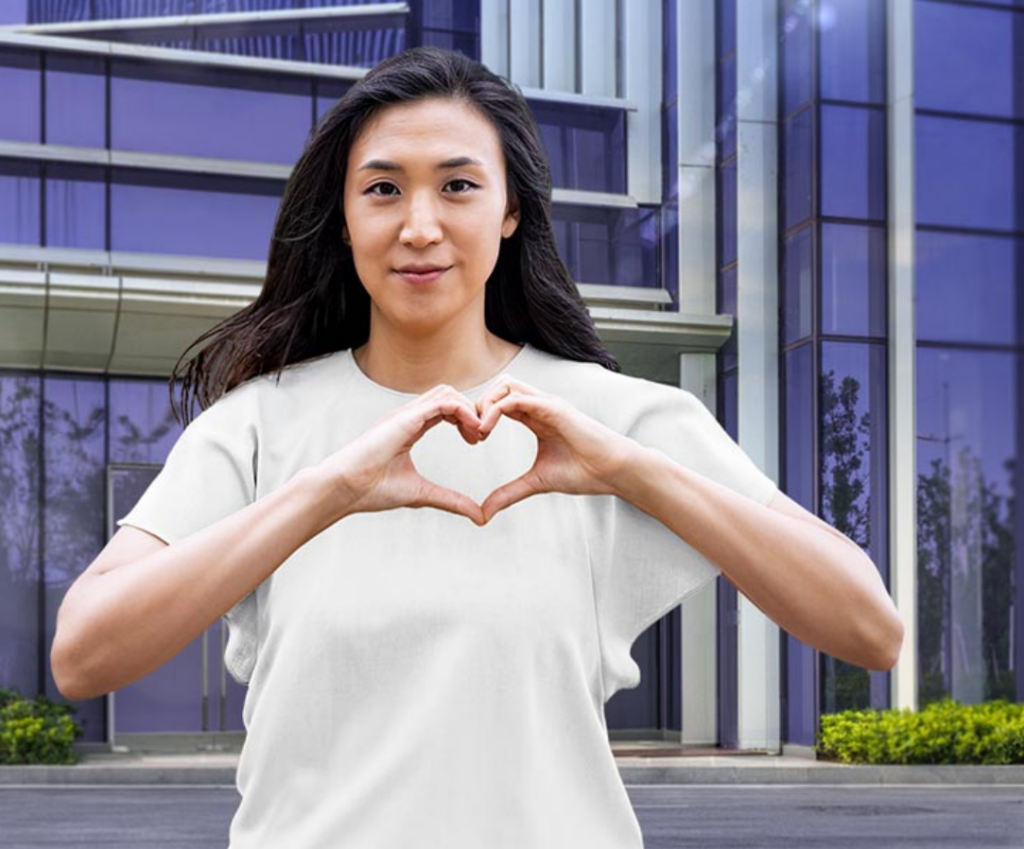
This year’s “Inspiring Inclusion” hand-heart pose may seem innocent, but it perpetuates the stereotype that women are defined by their emotional and nurturing qualities. This gesture reduces the rich diversity of women’s experiences and contributions, reinforcing traditional gender roles and going against the spirit of IWD.
How to celebrate International Women’s Day
By using the hand-heart gesture in International Women’s Day communications, you could inadvertently be doing more harm than good. But if this is the case, what are some alternative ways that organisations can celebrate women’s accomplishments in a meaningful way?
- Centre comms around the official UN IWD theme, Invest in women: Accelerate progress
- Shine the spotlight on female employee experiences through webinars, podcasts or panel discussions
- Amplify the voices of women in your business by inviting them to share their own stories
- Highlight any initiatives specifically designed to support women within the business
- Make public commitments to furthering gender equality in your organisation
- Provide educational content that helps audiences understand gender equality issues
- Partner with organisations that focus on women’s rights and empowerment
Need support creating impactful International Women’s Day communications? Let’s talk.
Want to see what we can do for you? Check out some of our work building inclusive cultures and celebrating diversity here.
Creating a more neuroinclusive work environment
By Sally Pritchett
CEO
With many citing empowering neurodivergent talent as a business imperative, discover how your workforce can behave in a more neuroinclusive way.
Embracing neurodiversity within your workforce can introduce fresh perspectives, new ways of thinking, and innovative ideas. According to Deloitte, “organizations that make an extra effort to recruit, retain, and nurture neurodivergent workers can gain a competitive edge from increased diversity in skills, ways of thinking, and approaches to problem-solving.”
With studies showing that an estimated 15-20% of adults are neurodivergent, businesses that neglect to take measures to recognise, embrace and support people who are neurodiverse, risk being left behind.
Neurodiversity isn’t a superpower. However, by empowering a diverse workforce, and creating a workplace environment where everyone feels understood and accepted, employees can feel psychologically safer and more able to share different perspectives and approaches.
There are some simple steps we can encourage employees to take to better support their neurodiverse colleagues.
So, what steps can we give our teams to help them work in a more neuroinclusive way?
In an office environment…
Reduce office overstimulation
Think about a typical office environment – bright lights, unexpected noises, different smells, lots of people moving around. This can make offices very overstimulating for many people. Consider ways you can help reduce office overstimulation. This could involve encouraging team members to take calls and eat their lunch away from the main office area, or to use headphones when watching videos.
Respect quiet spaces
If someone takes themselves away from a main office space to work it may be that they are looking for a quieter environment to focus. When someone seeks a quieter space to work, ask your team to consider popping over a quick message asking for a discussion or scheduling a dedicated time to talk.
When sharing information or tasks…
Give specific instructions
Don’t expect people to read between the lines. It can be very difficult for someone to pinpoint exactly what they need to do or achieve if they are not given specific instructions. Encourage clear and direct communication.
Avoid unclear information
We like the ‘What you need, by when, and why’ basis for giving them instructions , shared by Ellie Middleton in her highly recommended Nano Tips for Working Inclusively with Neurodivergent Employees LinkedIn Learning course. Saying things like ‘this is urgent’ but without clearer instructions can be overwhelming, as people’s perceptions of urgency can be different. Encourage your team to provide clear timeframes to help colleagues plan their time accordingly or rearrange tasks if needed.
Keep everyone on the same page
Have all processes and policies written down so that everyone has access to clear guidelines. Ensure that everyone knows where and how to access these processes and policies so they can refer to them as they need to.
Make information available
Neurodivergent people can become overwhelmed by not having enough information. Make sure all the details people could need in the workplace or for specific tasks are accessible. It can also help to provide people with the opportunity to ask for further information if they require it.
When working together…
Adapt communication styles
We all communicate with one another in different ways, and some people feel more confident expressing themselves through specific methods of communication. Encourage your team to tune in to and understand each other’s preferred ways of communicating, and adapt to these styles where possible. For example, when asking for ideas or feedback in a meeting, you could also give people an opportunity to share their thoughts via email after the discussion.
Embrace diverse work styles
It’s important to recognise and appreciate that people have varied work rhythms. By focusing on outcomes, instead of the way someone reaches that outcome, people can feel more comfortable working in a way that helps them deliver their best work.
Share information early
Help everyone prepare by always sharing meeting agendas and information in advance. This gives people a chance to digest the information they need to understand and feel comfortable and confident when they get into a meeting.
Pop over a message before calls
Unexpected calls or meetings can disrupt people or cause them to feel unprepared for or anxious about the incoming call. Suggest that colleagues send a quick message before making calls to help ensure a productive conversation, and give people time to prepare for and get into the right mindset for the call.
Neuroinclusion benefits everyone
As we’ve discussed, diversity brings new perspectives and ways of thinking about things. Better support of neurodivergent people can help us all to access different perspectives and approaches. A neuroinclusive environment nurtures a culture of empathy and acceptance, enhancing the workplace and strengthening teamwork.
However, reading through these tips you may have felt that they are really just some best practice and sensible suggestions on ways of working with other people. Neuroinclusive practices foster clearer communication, patience, and understanding among all team members – both neurodivergent and neurotypical. An inclusive approach paves the way for better interactions and collaboration, benefiting everyone.
Are you ready to talk about neuroinclusion?
If you want to start the conversation about neuroinclusive working with your employees, get in touch as we can support you with creating engaging communications that help nurture an inclusive workplace culture.
Q2 2024 Awareness Days Calendar
By Sally Pritchett
CEO
Download your free Awareness Days Calendar for Q2 2024.
Don’t miss an important date in the second quarter of the year with our downloadable calendar that includes key employee wellbeing, sustainability and environmental, and diversity and inclusion awareness days.
These are all important topics that should be high on the agenda for every business. Our Q2 2024 Awareness Days Calendar can help you:
- Plan your employee wellbeing programmes.
- Raise the profile of your sustainability activities.
- Keep your diversity and inclusion engagement programmes on track.
- Effectively engage your employees with important conversations.
- Recognise events that are important to colleagues and customers.
If you’re looking for support to make the most of these opportunities, get in touch to see how we can help.
Download our Key Awareness Days Calendar for Q2 2024
5 trends that we expect will shape workplace culture in 2024
By Sally Pritchett
CEO
Curious about the evolving workplace culture in 2024? Explore these five key employee priorities.
Workplace culture has a profound impact on employee engagement, productivity, and morale, so organisations must keep up with what is important to employees to help nurture a positive environment. With 45% of UK employees saying a great culture is the most important factor when looking for a new job, what should employers be looking out for in 2024?
1. Flexibility will continue to be key
The pandemic changed the way many of us work, driving a surge in the number of employees working from home. In 2023, some companies continued with fully remote working, whereas others have started to implement return-to-office policies and hybrid work options. But what could happen in 2024?
We expect to see more of a shift towards employees wanting flexibility, rather than just the opportunity to work from home. With 71% of workers saying a flexible working pattern is important to them when considering a new role, this suggests employees are looking for flexibility around arrangements such as start and finish times or where they work from too, to help them achieve a better work-life balance.
2. Prioritising employee mental health and wellbeing
We believe nurturing a healthy culture that supports employee mental health and wellbeing is one of the biggest areas of importance for 2024. In 2020-2021 alone, .
Although the effect of not prioritising employee wellbeing on productivity is clear, nurturing a healthy workplace culture is about much more than just the financial impact. In a workplace where wellbeing is prioritised, there is likely to be higher employee morale, reduced turnover, and increased job satisfaction.
3. The demand for sustainability
With Gen Z joining the workforce, they are beginning to influence workplace culture. By 2025, Gen Z will account for 27% of the workforce, so employers will need to start listening to what’s important to them if they wish to attract and retain the next generation of talent.
With 50% of Gen Zs saying they are pushing their employer to drive change on environmental issues, it’s clear that sustainability is an important matter that employers need to prioritise as part of their workplace culture initiatives. However, as well as businesses looking at organisational sustainability initiatives, part of building an environmentally conscious workplace culture involves supporting and empowering employees to make better choices in their lives outside of work.
4. Employees want to feel a sense of belonging
This year, diversity, equity and inclusion have become increasingly important in the workplace. In 2024, the focus on DEIB is set to continue. 65% of employees admit they want to feel a strong sense of belonging at work, suggesting employers need to start going further than just having a DEIB policy.
Many employees now want to feel like part of a community at work, form stronger connections with colleagues, and feel like they can be their true selves at work. To help nurture this type of culture, employers need to ensure their DEIB initiatives are accessible, thorough, and most importantly, authentic.
5. The importance of internal communications
Internal communications help keep employees informed, engaged and connected to a business. However, effective internal communications are about more than just sending out a monthly email newsletter to employees. There are many channels that employers can, and should, use to keep employees engaged with the business. This is particularly important for reaching frontline workers, where email isn’t necessarily the best way to communicate with the workforce.
As we approach 2024, nurturing a healthy, safe and thriving workplace culture has never been more important. If you’re looking for some support in developing internal communications strategies or initiatives that engage your workforce, we’re here to help.
Navigating AI Together: Making AI an ally to inclusive communications
By Sally Pritchett
CEO
How can we tackle AI bias for more inclusive and authentic representation?
At our recent ‘Navigating AI Together’ roundtable, we delved into the critical issue of biases within AI and how we can look to overcome the in-built bias and use AI as a tool to foster inclusion and authentic representation.
We were delighted to welcome Ali Fisher, a seasoned expert in fostering sustainable, diverse, equitable, and purpose-driven business practices. With a background including leadership at Unilever and the Dove Self-Esteem Project, Ali brought a wealth of knowledge and experience in the realm of DE&I. Her invaluable insights provided fresh perspectives on navigating AI’s impact on communications.
Unravelling bias in AI
Generative AI offers amazing opportunities for communicators, but its power comes with a challenge: inherent biases. Generative AI has been trained on human-created content, and so has inherited deep-seated bias built in. This bias can, and often does, unintentionally permeate AI-generated content, reinforcing stereotypes and misconceptions.
It’s been well documented and discussed over the last year that generative AI takes bias and stereotyping from bad to worse – with Bloomberg publishing headlines like ‘Humans are biased, generative AI is even worse’. This bias is of course very worrying when we’re also seeing reports that 73% of users globally already say they trust content created by generative AI.
But let’s go back a step. While generative AI may be biased due to the training data that feeds it, what about the conditions under which the AI tools themselves are developed?
The lack of diversity within the tech industry adds complexity. The gender disparity is evident, with only 22% of the UK tech sector and 21% of US computer science degree earners being women. One study showed that code written by women was approved the first time round more often than men’s, but only if the gender of the coder was hidden. If the gender was revealed, the data showed that women coders received 35% more rejections of their code than men.
Race and ethnicity disparities in tech are also concerning. Looking at the US and a report from the McKinsey Institute of Black Economic Mobility, Black people make up 12% of the US workforce but only 8% of employees in tech jobs. That percentage is even smaller further up the corporate ladder, with just 3% of tech executives in the C-suite being Black. It’s believed that the gap will likely widen over the next decade.
Nurturing AI as responsible guides
During our ‘Navigating AI together’ roundtable, an analogy was shared: AI is like a toddler trying to cross a busy road. Like how we wouldn’t allow a toddler to wander into traffic alone, we must hold the hand of AI and safely guide it.
We need to understand the EDI landscape thoroughly first, becoming adept guides before we can expect AI to generate outputs that are genuinely inclusive and authentically representative. As humans, we need to be responsible AI users, always giving a guiding hand. The first step to making AI an ally to inclusive communications is self-reflection.
Navigating our human bias
We’re human, and we’re fallible, and it is important to remember that in the context of EDI.
In one study, researchers observed 9-month-old babies, evenly divided between Black and white infants. They were all equally exposed to both Black and white adults, all unknown to them. The white babies consistently gravitated toward the white adults, while the Black infants showed a preference for the Black adults. This inclination toward familiarity emerged as early as nine months, suggesting an inherent comfort with those we perceive as similar.
As humans, we tend to categorise. We employ schemas and, yes, stereotypes as well. It’s a coping mechanism and our brain’s attempt to simplify the barrage of information we encounter daily. Yet, this simplification comes with a call for heightened awareness. We need to consciously slow down, be vigilant and actively recognize these tendencies within ourselves.
Increasing awareness of our unconscious biases
Unconscious bias refers to the automatic attitudes and stereotypes that influence our judgments and actions without our conscious awareness. Shaped by our experiences and societal influences, these biases impact how we view others.
If you’re considering using AI within your communications, then you must understand what your own unconscious biases are. The Harvard IATs – Implicit Association Tests – are a useful tool to help you begin to do this. Set up by a collaboration of US researchers in 1998 Project Implicit aims to collect data on our biases as we learn about ourselves. We’d recommended picking one identity characteristic you think you don’t carry bias on and one you think you do – and see how it plays out.
Exploring bias in generative AI
Moving on from understanding why generative AI contains bias and recognising how our biases influence our perceptions, let’s shift our focus to examining the actual AI outputs. You likely have already encountered biased outputs from AI, but in our session, we made several comparisons between the results of Google’s image search results algorithm and the outputs from generative AI tools ChatGPT and Midjourney.
Let’s start with a familiar scenario: the image of a courier. When you think of a courier – the person who delivers your Amazon packages – what’s the immediate mental picture that springs to mind?
A quick Google image search result shows a courier as a man carrying a box, often with a van. This representation is the outcome of the content humans have uploaded – it’s not a product of machine learning.
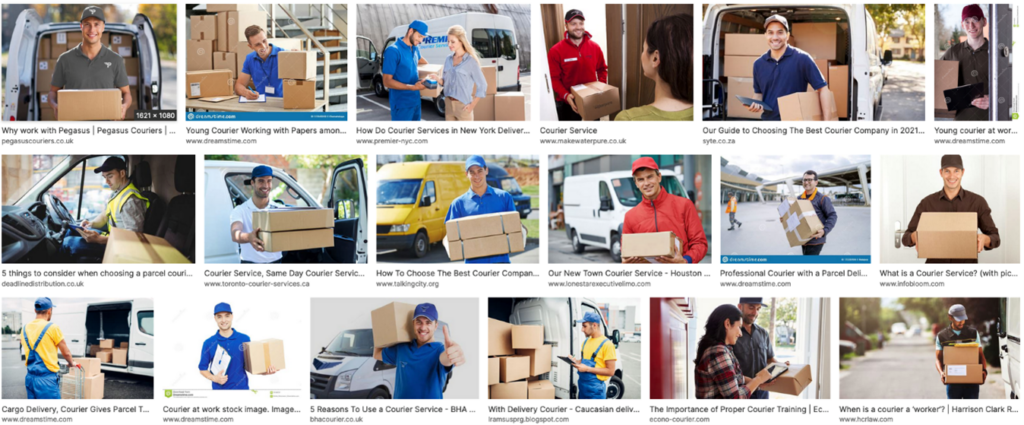
Now, let’s compare it to what AI, drawing from its training data, perceives as a courier’s life.
When we prompted ChatGPT to describe a day in the life of a courier, it conjured a narrative around a character named Jake.
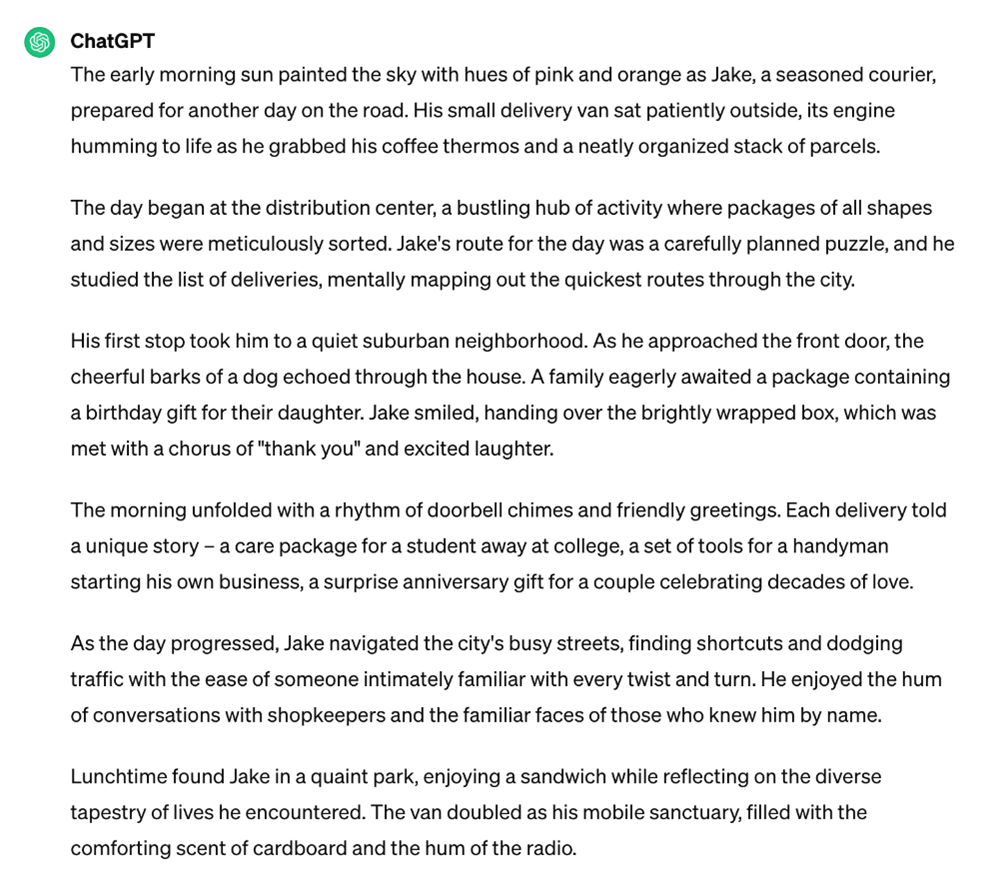
Similarly, looking at Midjourney’s output, we have images suggesting men with boxes and motorbikes as representations of couriers.

Over the course of the roundtable, we shared and discussed many examples showing the bias of AI. To get a better understanding of this, we recommended watching Amy Web’s presentation at the Nordic Business Forum. Amy revealed how AI mirrors human biases. From CEOs to tampons, AI struggled.
It’s safe to say that AI does not challenge the perception of who a person could be. It often reflects society’s most ingrained stereotypes at us and fails to accurately reflect a range of EDI characteristics that humans have.
AI and authentic representation
There are only four EDI identity characteristics that we see or perceive easily – tone of voice, mannerisms, attire, and skin colour. Everything else requires more information from the individual. We can’t accurately assume someone’s age, gender, sexual orientation, race or ethnicity. We can’t assume whether someone has a disability or not.
So how does AI fare when it comes to navigating these visible and invisible EDI characteristics?
If you ask Midjourney to show you construction workers, you’ll likely get something like this, with a clear lack of visible diversity among the four images.

We then asked Midjourney to depict construction workers with a disability. The generated images were all very similar, with three of the four depicting the construction worker as a wheelchair user.
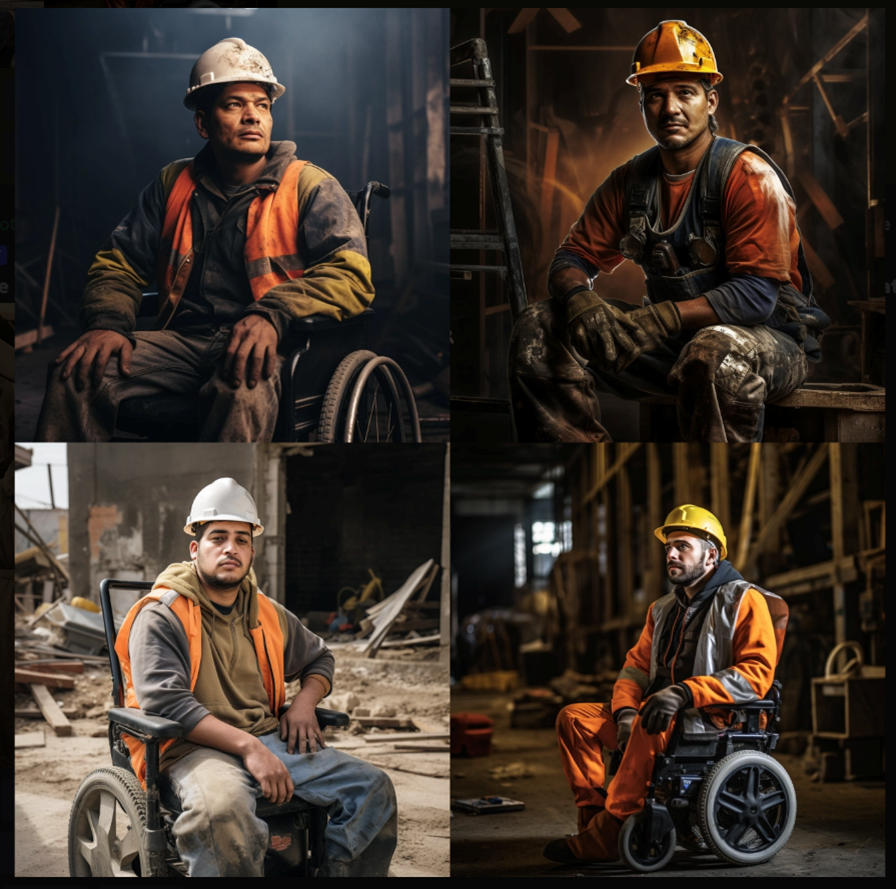
We then asked Midjourney to depict LGBTQIA+ construction workers. This output really shows the propensity of AI to stereotype.

When it comes to minority groups, AI seems to at best lean on lazy stereotypes, and at worst create an offensive parody of reality. These results show how important it is for us to be hyper-aware of EDI within our communications when using AI, and to hold the hand of that toddler crossing the road tightly!
How to make AI an ally to inclusive communications
As the human communicators guiding the hand of AI, reducing our personal bias has to be the first step:
- Engage in the Harvard IATs to heighten awareness of your unconscious biases
- Be prepared to get it wrong and learn from your mistakes
- Evaluate the diversity in your social and professional circle
- Challenge yourself to culture-add, not culture-fit
- Practice active listening, valuing others’ perspectives over your own voice
With that foundation in place, our top tips for reducing AI bias are:
- Craft prompts carefully to guide unbiased outcomes
- Offer contextual details for to help AI better understand your expectations and requirements
- Fact check for genuine and authentic representation in all AI-generated content
- Offer corrective feedback to steer AI responses towards inclusivity
- Develop ethical guidelines for all AI users and undertake through training
Reach out to us or Ali for a deeper conversation on how you can cultivate a culture that embraces and understands the value of DEIB within your organisation.
To join our upcoming ‘Navigating AI Together’ session in 2024, please send an email over to hello@somethingbig.co.uk to stay in the loop.




